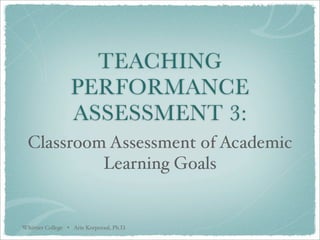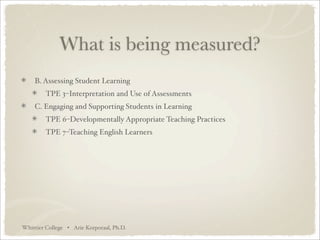TPA3 Overview
- 2. TEACHING PERFORMANCE ASSESSMENT 3: Classroom Assessment of Academic Learning Goals Whittier College âĒ Arie Korporaal, Ph.D.
- 4. TPA 3: Overview Whittier College âĒ Arie Korporaal, Ph.D.
- 5. TPA 3: Overview 1. You will demonstrate your ability to select a unit of study and learning goal(s) and to plan standards-based, developmentally-appropriate student assessment activities for a group of students. In addition, you will demonstrate your ability to assess student learning and diagnose student needs from particular responses to the assessment activity. Whittier College âĒ Arie Korporaal, Ph.D.
- 6. TPA 3: Overview 1. You will demonstrate your ability to select a unit of study and learning goal(s) and to plan standards-based, developmentally-appropriate student assessment activities for a group of students. In addition, you will demonstrate your ability to assess student learning and diagnose student needs from particular responses to the assessment activity. 2. You will demonstrate your ability to make assessment adaptations for two focus students: an English learner and a student with identiïŽed special needs. Whittier College âĒ Arie Korporaal, Ph.D.
- 7. TPA 3: Overview 1. You will demonstrate your ability to select a unit of study and learning goal(s) and to plan standards-based, developmentally-appropriate student assessment activities for a group of students. In addition, you will demonstrate your ability to assess student learning and diagnose student needs from particular responses to the assessment activity. 2. You will demonstrate your ability to make assessment adaptations for two focus students: an English learner and a student with identiïŽed special needs. 3. You will score, review, and analyze evidence of student learning and will reïŽect on assessment implications. Whittier College âĒ Arie Korporaal, Ph.D.
- 8. TPA 3: Overview 1. You will demonstrate your ability to select a unit of study and learning goal(s) and to plan standards-based, developmentally-appropriate student assessment activities for a group of students. In addition, you will demonstrate your ability to assess student learning and diagnose student needs from particular responses to the assessment activity. 2. You will demonstrate your ability to make assessment adaptations for two focus students: an English learner and a student with identiïŽed special needs. 3. You will score, review, and analyze evidence of student learning and will reïŽect on assessment implications. 4. You will submit your completed response, the assessment, selected student assessment responses and, if appropriate, scoring scales, rubrics, or scoring guides as artifacts. Whittier College âĒ Arie Korporaal, Ph.D.
- 9. What is being measured? Whittier College âĒ Arie Korporaal, Ph.D.
- 10. What is being measured? B. Assessing Student Learning TPE 3âInterpretation and Use of Assessments Whittier College âĒ Arie Korporaal, Ph.D.
- 11. What is being measured? B. Assessing Student Learning TPE 3âInterpretation and Use of Assessments C. Engaging and Supporting Students in Learning TPE 6âDevelopmentally Appropriate Teaching Practices TPE 7âTeaching English Learners Whittier College âĒ Arie Korporaal, Ph.D.
- 12. What is being measured? B. Assessing Student Learning TPE 3âInterpretation and Use of Assessments C. Engaging and Supporting Students in Learning TPE 6âDevelopmentally Appropriate Teaching Practices TPE 7âTeaching English Learners D. Planning Instruction and Designing Learning Experiences for Students TPE 8âLearning About Students TPE 9âInstructional Planning Whittier College âĒ Arie Korporaal, Ph.D.
- 13. What is being measured? B. Assessing Student Learning TPE 3âInterpretation and Use of Assessments C. Engaging and Supporting Students in Learning TPE 6âDevelopmentally Appropriate Teaching Practices TPE 7âTeaching English Learners D. Planning Instruction and Designing Learning Experiences for Students TPE 8âLearning About Students TPE 9âInstructional Planning F. Developing as a Professional Educator TPE 13âProfessional Growth Whittier College âĒ Arie Korporaal, Ph.D.
- 14. TPA 3: Step 1 Assessment Selection and Planning for the Whole Class Whittier College âĒ Arie Korporaal, Ph.D.
- 15. TPA 3: Step 1 Assessment Selection and Planning for the Whole Class Select a class and identify the content area, subject matter, student academic content standards, and unit of study with which you will be working. Whittier College âĒ Arie Korporaal, Ph.D.
- 16. TPA 3: Step 1 Assessment Selection and Planning for the Whole Class Select a class and identify the content area, subject matter, student academic content standards, and unit of study with which you will be working. Describe the purpose and type of assessment and the evidence of student learning that will be collected. Whittier College âĒ Arie Korporaal, Ph.D.
- 17. TPA 3: Step 1 Assessment Selection and Planning for the Whole Class Select a class and identify the content area, subject matter, student academic content standards, and unit of study with which you will be working. Describe the purpose and type of assessment and the evidence of student learning that will be collected. Describe the plan for implementation of the assessment, including strategies, activities, grouping, and materials. Whittier College âĒ Arie Korporaal, Ph.D.
- 18. TPA 3: Step 1 Assessment Selection and Planning for the Whole Class Select a class and identify the content area, subject matter, student academic content standards, and unit of study with which you will be working. Describe the purpose and type of assessment and the evidence of student learning that will be collected. Describe the plan for implementation of the assessment, including strategies, activities, grouping, and materials. Explain how you will use the assessment results and provide feedback regarding student progress towards achievement of the academic learning goal(s). Whittier College âĒ Arie Korporaal, Ph.D.
- 19. TPA 3: Step 2 Learning about Students: Whole Class and Two Focus Students Whittier College âĒ Arie Korporaal, Ph.D.
- 20. TPA 3: Step 2 Learning about Students: Whole Class and Two Focus Students Select two students within the class, including one English Learner and one student with an identiïŽed special need. Whittier College âĒ Arie Korporaal, Ph.D.
- 21. TPA 3: Step 2 Learning about Students: Whole Class and Two Focus Students Select two students within the class, including one English Learner and one student with an identiïŽed special need. Complete a detailed description of the background and characteristics of each of the two students, as well as an explanation of how the information will inïŽuence instructional planning and assessment. Whittier College âĒ Arie Korporaal, Ph.D.
- 22. TPA 3: Step 3 Assessment Adaptations for Two Focus Students Whittier College âĒ Arie Korporaal, Ph.D.
- 23. TPA 3: Step 3 Assessment Adaptations for Two Focus Students Complete a detailed description of the background and characteristics of each of the two students, as well as an explanation of how the information will inïŽuence instructional planning and assessment. Whittier College âĒ Arie Korporaal, Ph.D.
- 24. TPA 3: Step 3 Assessment Adaptations for Two Focus Students Complete a detailed description of the background and characteristics of each of the two students, as well as an explanation of how the information will inïŽuence instructional planning and assessment. Explain your rationale for the adaptations. Whittier College âĒ Arie Korporaal, Ph.D.
- 25. TPA 3: Step 4 Giving the Assessment to the Whole Class, Including Two Focus Students Whittier College âĒ Arie Korporaal, Ph.D.
- 26. TPA 3: Step 4 Giving the Assessment to the Whole Class, Including Two Focus Students Give the assessment to the class; collect and score the evidence of student learning from the assessment. Whittier College âĒ Arie Korporaal, Ph.D.
- 27. TPA 3: Step 4 Giving the Assessment to the Whole Class, Including Two Focus Students Give the assessment to the class; collect and score the evidence of student learning from the assessment. Submit copies of three assessment responses that represent the range of student achievement on the assessment and explain the selection of those three responses. Whittier College âĒ Arie Korporaal, Ph.D.
- 28. TPA 3: Step 4 Giving the Assessment to the Whole Class, Including Two Focus Students Give the assessment to the class; collect and score the evidence of student learning from the assessment. Submit copies of three assessment responses that represent the range of student achievement on the assessment and explain the selection of those three responses. Submit copies of the two focus studentsâ responses. Whittier College âĒ Arie Korporaal, Ph.D.
- 29. TPA 3: Step 5 Analyzing Evidence of Student Academic Learning and the Assessment Whittier College âĒ Arie Korporaal, Ph.D.
- 30. TPA 3: Step 5 Analyzing Evidence of Student Academic Learning and the Assessment Discuss what you learned from the assessment about your studentsâ progress toward achievement of the learning goal(s). Whittier College âĒ Arie Korporaal, Ph.D.
- 31. TPA 3: Step 5 Analyzing Evidence of Student Academic Learning and the Assessment Discuss what you learned from the assessment about your studentsâ progress toward achievement of the learning goal(s). Discuss what you learned from the assessment about your studentsâ progress toward achievement of the learning goal(s). Whittier College âĒ Arie Korporaal, Ph.D.
- 32. TPA 3: Step 5 Analyzing Evidence of Student Academic Learning and the Assessment Discuss what you learned from the assessment about your studentsâ progress toward achievement of the learning goal(s). Discuss what you learned from the assessment about your studentsâ progress toward achievement of the learning goal(s). For Student 1 and Student 2: Analyze each studentâs response to the assessment. Discuss how this information will aïŽect your future planning and instruction for the two students. Whittier College âĒ Arie Korporaal, Ph.D.
- 33. TPA 3: Step 6 ReïŽection on Assessment Whittier College âĒ Arie Korporaal, Ph.D.
- 34. TPA 3: Step 6 ReïŽection on Assessment Read your responses to Steps 1-5. Whittier College âĒ Arie Korporaal, Ph.D.
- 35. TPA 3: Step 6 ReïŽection on Assessment Read your responses to Steps 1-5. Discuss what you learned about the assessment and about your studentsâ learning as a result of using the assessment. Whittier College âĒ Arie Korporaal, Ph.D.
- 36. TPA 3: Step 6 ReïŽection on Assessment Read your responses to Steps 1-5. Discuss what you learned about the assessment and about your studentsâ learning as a result of using the assessment. Explain how you will use what you have learned about assessment in the future. Whittier College âĒ Arie Korporaal, Ph.D.
- 37. TPA 3: Step 6 ReïŽection on Assessment Read your responses to Steps 1-5. Discuss what you learned about the assessment and about your studentsâ learning as a result of using the assessment. Explain how you will use what you have learned about assessment in the future. Identify your goal(s) for increasing your knowledge and skill in assessment. Whittier College âĒ Arie Korporaal, Ph.D.
- 38. After Completing Your Response Whittier College âĒ Arie Korporaal, Ph.D.
- 39. After Completing Your Response Remove all last names and identifying references to children and adults on the response and artifacts. Whittier College âĒ Arie Korporaal, Ph.D.
- 40. After Completing Your Response Remove all last names and identifying references to children and adults on the response and artifacts. Procure Student Release Forms and Adult Release Forms for all student and/or adult work to be submitted. Whittier College âĒ Arie Korporaal, Ph.D.
- 41. After Completing Your Response Remove all last names and identifying references to children and adults on the response and artifacts. Procure Student Release Forms and Adult Release Forms for all student and/or adult work to be submitted. Submit the signed release forms, your response, and all artifacts, as directed by your program. Your artifacts will include: The assessment and any directions, scoring guides, answer keys, etc. A total of ïŽve student responses: three representing the range of student achievement on the assessment and one response from each of the two focus students. Whittier College âĒ Arie Korporaal, Ph.D.










































